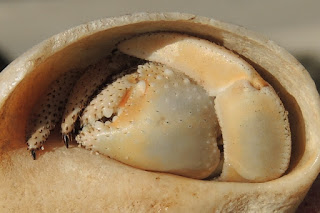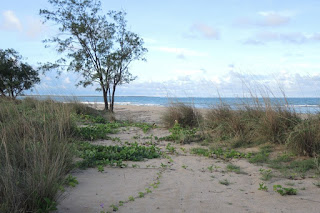Many pet hermit crabs come from the Northern Territory in Australia. Terrestrial hermit crabs have a planktonic larval stage in the sea, so they are not the sort of animal that
is easy to breed in captivity. As a consequence most pet hermit crabs are wild collected. At least 30 000 crabs are sold to the aquarium trade every year according to official records. These crabs are sold both within Australia and in North America and Europe.
In Australia, one species of terrestrial hermit crab (
Coenobita variabilis) is found across the top end of the Northern Territory and some other species are found on coral cays in the Coral Sea/Great Barrier Reef. Hermit crabs occur in places where they have access to seawater, freshwater and terrestrial vegetation. In practice this probably restricts them to low energy shorelines or rocky coasts where they can scramble over the rocks to reach pools of seawater without getting washed into the sea. Most terrestrial crabs drown if they are underwater for a prolonged period and I suspect that these hermit crabs would do so too. People who keep hermit crabs report a freshwater requirement but I am not sure how they find freshwater in their habit as these places have prolonged dry seasons and the ground is very porous. The availability of sea shells probably limits where the hermit crabs can live. Even though good habitat appears to be available in Far North Queensland, for example, this area has very few gastropod shells on the beach but is rich in useless bivalve shells.
The Northern Territory is a land of strange rocky coastlines that are perfect for hermit crabs. Over aeons minerals leached from the tropical soils are deposited in layers in the ground that area exposed on the coast. Bauxite, laterite, hard clays, beach rock and occasionally cemented sand create a wild array of coastal geologies.
 |
| Bauxite cliff with kaolin and laterite lower layers - a place riddled with hiding places |
Hermit crabs appear to mainly inhabit crevices in the rock formations near the water's edge during the day then go foraging in the grasslands and forest patches at night. For a slow moving animal that makes an unmistakable track, they sure are hard to find at night. The only time they were easy to observe was when they were climbing up the cliffs and sand dunes in the late afternoon. As soon as they see you coming, even if you are more than 5 metres away, they often just let go and rolled down all the way to the bottom.
 |
| During the day hermit crabs also hide under these cemented sand boulders |
 |
| Some hermit crabs climb straight up the slip face of the sand dune, which must be really hard |
 |
| Other hermit crabs seem to follow well-known paths |
Hermit crabs tend to live in colonies where they seem to get along peacefully. Living in colonies helps hermit crabs find new shells as when larger crabs find a new shell the old shell becomes available for smaller crabs and a cascade of shell updating may occur as progressively smaller crabs each upgrade their shells. There are actually scientific papers written on this phenomenon, which is known as
vacancy chaining. Crabs actually hang around with slightly larger crabs hoping to grab their old shells when they upgrade. When a number of crabs of different sizes group together in order to upgrade with the big guy does, this is a vacancy chain.
On capture, terrestrial hermit crabs can be quite feisty and will attack fingers, even though they have to come along way out to do so. If they feel threatened, they pull back into their shells and block the entrance with their nippers and legs, something that marine hermit crabs can't do. Marine hermit crabs are timid in comparison.
 |
| Terrestrial hermit crabs are not shy |
 |
| Terrestrial hermit crabs can also seal the door with their legs. |
Terrestrial hermit crabs feed on a variety of things but probably eat mainly vegetation. In captivity, they readily eat the vegetables that people eat. In the wild, I was only able to observe them eating an old mangrove dropper (
Rhizophora stylosa propagule)
 |
| Typical seaside grassland habitat |
 |
| Laterite and beach rock shelves on beaches also provide foraging areas. |
 |
| Hermit crabs feeding on mangrove propagule |
Hermit Crabs as Pets
When it comes to invertebrates, I think that hermit crabs are one of the best choices there is. They live up to 10 years, which is longer than almost all insects. They are also quite active and move around on the surface, unlike many insects which bury themselves in soil as soon as they get a chance. Insects can also be very robotic with a very limited set of behaviours. In contrast, hermit crabs seem to explore their enclosures and active hide from us when we get close. They pull back into their shells and roll down of what ever object they were climbing or try to run under something. They also try to burrow under their water bowl and will climb up anything and will swing from the roof of their enclosure if they get the chance.
Hermit crabs can't tell us how they feel so we have to look for indirect signs of whether they are happy to be pets. So far, I have only had to release one invertebrate because it was so desperate to escape that it was not worth keeping and that animal was a red claw (
Cherax quadricarinatus). Most insects are clearly not worried about being contained provided they have food, water and mates. If invertebrates are unhappy, they tend to lurch around their enclosures constantly. I think that hermit crabs are on the verge of intelligence and require some additional care to make their enclosures interesting. Hermit crabs also require warmth and fresh and saltwater. They are very easy to feed, eating many human foods. They also like the company of their kin and lots of empty shells to try out. Give them what they want and they will be happy. People are crazy for hermit crabs and there are
many pages with good advice on keeping them.






















